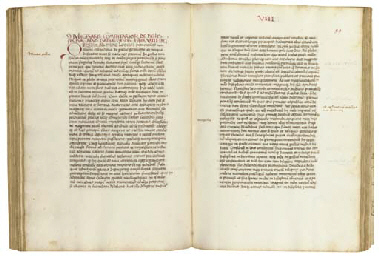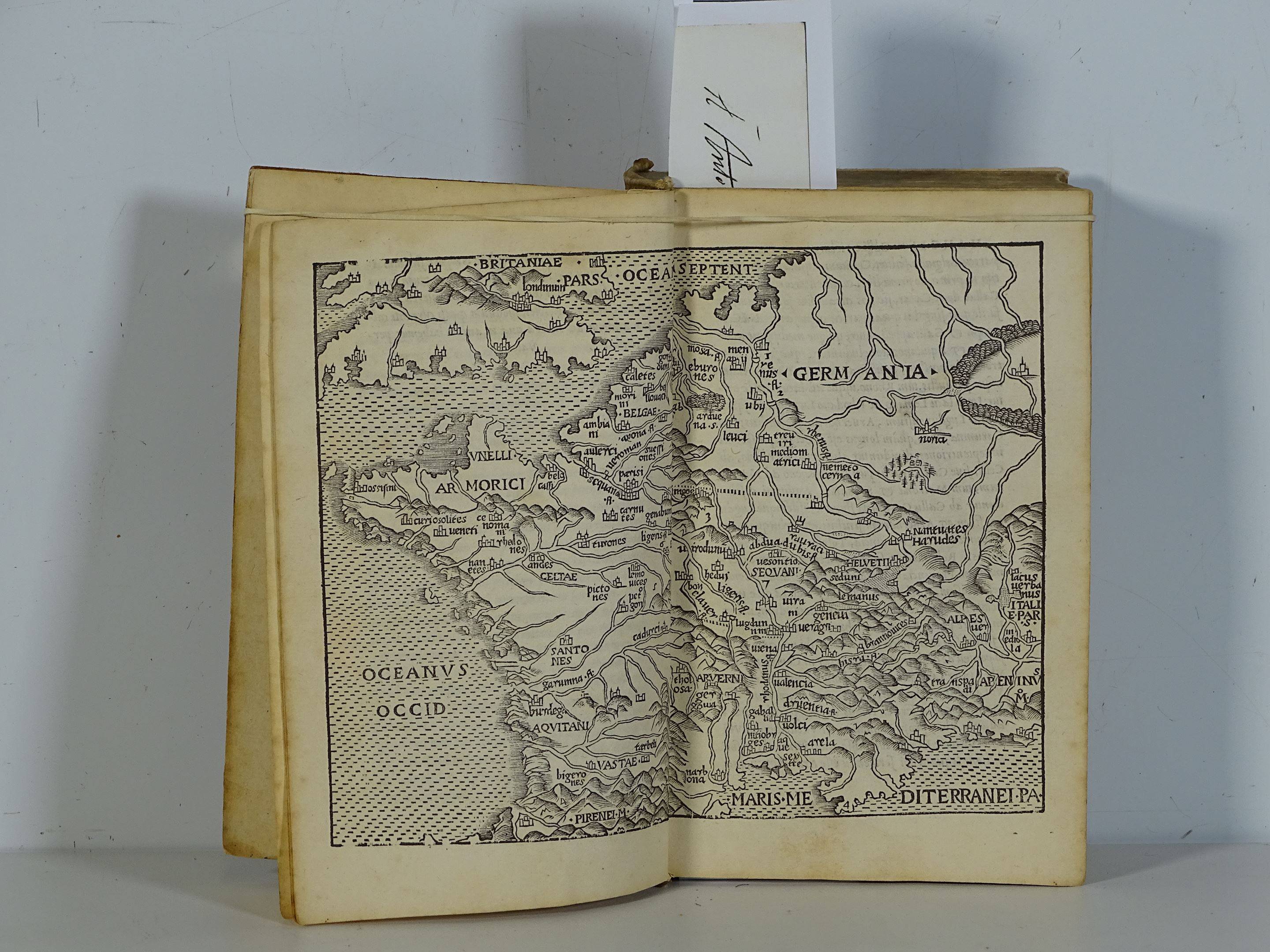Title: Commentarii de bello Gallico Author: Caesar, Julius Place: [Salzburg, Austria?] Publisher: Date: 1463 Description: 84 leaves of text, written in ink on both sides, complete. 11½x8½” (291x215 mm.); period blindstamped calf over wooden boards, metal clasps, rebacked with original spine strip laid down. Rare and very handsome Renaissance manuscript of Caesar’s important commentaries on his wars in Gaul, predating the earliest printed edition by six years. Ceasar’s Commentaries on the Gallic Wars, one of the great Classical text, was a popular work among scholars and humanists of the Middle Ages and Renaissance. It gives an eloquent and credible eyewitness account of ancient history, and is one of the few ancient texts dealing with the history of Europe north of the Alps, being thus a crucial source for the history of France, Britain and Germany. A well-established manuscript tradition for this text exists independent of that belonging to Caesar’s Collected Works. Approximately 75 manuscripts are known to exist, the large majority dating from the 15th century. The text of this manuscript probably stems from a 9th century French exemplar, which peculiarly concludes its text (as here) with a misplaced passage from Book VIII – a feature of transcription existing in approximately 25% of the known copies. The date of the present manuscript is given in the colophon. There are two manuscript deeds used as flyleaves, dated 1458 and 1461, which relate to the diocese of Salzburg, and together with the binding style and paper watermarking, Austria, and particularly Salzburg, as the place of origin is strongly suggested. Reinforcing this assumption is the unusual subdivisioning of the text. It is usually divided into eight books, but this manuscript atypically divides it into ten, Books I and VI each being divided into two parts. The subdivisioning gives added importance the Helvetian wars and to the customs of the Germans. The work was presumably so divisioned because such topics would be especially appealing to Austrian readers of 1463. Virginia Brown’s 1979 census study of Caesar manuscripts fails to note any manuscript with the subdivisioning exhibited here, and in this respect the present manuscript may well be unique. Austrian Renaissance manuscripts of a classical nature are very uncommon. Most Renaissance manuscripts of a classical nature were produced in Italy, and many of the examples now encountered are very late in their date of production, often postdating the printed text – the present example, superbly executed, is well before the earliest printing. With the bookplates of Oswald Seilern Aspang and Iosephus Iocabus Henricus de Battis. In custom-made half morocco folding box. Lot Amendments Condition: Minor scuffing to the well-restored covers, top 4” of original spine strip not present; some light and mostly marginal foxing and faint soiling, occasional marginal worming, small stain to lower gutter corner of earlier leaves, overall in fine condition. Item number: 175064
Title: Commentarii de bello Gallico Author: Caesar, Julius Place: [Salzburg, Austria?] Publisher: Date: 1463 Description: 84 leaves of text, written in ink on both sides, complete. 11½x8½” (291x215 mm.); period blindstamped calf over wooden boards, metal clasps, rebacked with original spine strip laid down. Rare and very handsome Renaissance manuscript of Caesar’s important commentaries on his wars in Gaul, predating the earliest printed edition by six years. Ceasar’s Commentaries on the Gallic Wars, one of the great Classical text, was a popular work among scholars and humanists of the Middle Ages and Renaissance. It gives an eloquent and credible eyewitness account of ancient history, and is one of the few ancient texts dealing with the history of Europe north of the Alps, being thus a crucial source for the history of France, Britain and Germany. A well-established manuscript tradition for this text exists independent of that belonging to Caesar’s Collected Works. Approximately 75 manuscripts are known to exist, the large majority dating from the 15th century. The text of this manuscript probably stems from a 9th century French exemplar, which peculiarly concludes its text (as here) with a misplaced passage from Book VIII – a feature of transcription existing in approximately 25% of the known copies. The date of the present manuscript is given in the colophon. There are two manuscript deeds used as flyleaves, dated 1458 and 1461, which relate to the diocese of Salzburg, and together with the binding style and paper watermarking, Austria, and particularly Salzburg, as the place of origin is strongly suggested. Reinforcing this assumption is the unusual subdivisioning of the text. It is usually divided into eight books, but this manuscript atypically divides it into ten, Books I and VI each being divided into two parts. The subdivisioning gives added importance the Helvetian wars and to the customs of the Germans. The work was presumably so divisioned because such topics would be especially appealing to Austrian readers of 1463. Virginia Brown’s 1979 census study of Caesar manuscripts fails to note any manuscript with the subdivisioning exhibited here, and in this respect the present manuscript may well be unique. Austrian Renaissance manuscripts of a classical nature are very uncommon. Most Renaissance manuscripts of a classical nature were produced in Italy, and many of the examples now encountered are very late in their date of production, often postdating the printed text – the present example, superbly executed, is well before the earliest printing. With the bookplates of Oswald Seilern Aspang and Iosephus Iocabus Henricus de Battis. In custom-made half morocco folding box. Lot Amendments Condition: Minor scuffing to the well-restored covers, top 4” of original spine strip not present; some light and mostly marginal foxing and faint soiling, occasional marginal worming, small stain to lower gutter corner of earlier leaves, overall in fine condition. Item number: 175064















Testen Sie LotSearch und seine Premium-Features 7 Tage - ohne Kosten!
Lassen Sie sich automatisch über neue Objekte in kommenden Auktionen benachrichtigen.
Suchauftrag anlegen